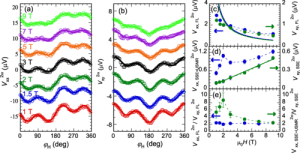
In collaboration with Prof. Kang Wang’s group at UCLA, Cheng, Yang and collaborators reported observation of unidirectional spin Hall magnetoresistance in Pt/α-Fe2O3 bilayers grown on α-Fe2O3 (0001). Spin Hall magnetoresistance (SMR) has been extensively used to probe magnetic and spin configurations in both ferromagnetic and antiferromagnetic heterostructures in the past decade. Recently, a new type of magnetoresistance, unidirectional SMR (USMR), has been observed in in HM/FM heterostructures. Compared with conventional SMR, the USMR is a non-linear magnetoresistance where the measured voltage depends quadratically on the applied electrical current. The magnitude of USMR unidirectionally depends on the angle between spin polarization and the FM magnetization, providing a more precise way to probe the spin state of the FM. The USMR in Pt/α-Fe2O3 bilayers has been observed through systematic field and temperature dependent measurements, which confirm the magnonic origin of the USMR. The appearance of USMR in Pt/α-Fe2O3 is driven by the imbalance of creation and annihilation of antiferromagnetic magnons by spin-orbit torque due to the thermal random field. Theoretical modeling reveals that the USMR in Pt/hematite, unlike its ferromagnetic counterpart, is determined by the antiferromagnetic magnon number with an apparent non-monotonic field dependence. The theoretical result can well explain the experimental observation, paving new ways for the highly sensitive detection of AFM spin states. This finding extends the generality of the USMR which pave the ways for the highly sensitive detection of AFM spin state.
This article was published in Physical Review Letters and is available here.
